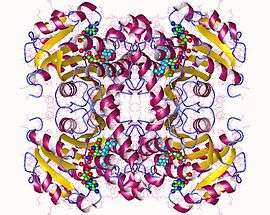Enoyl-acyl carrier protein reductase
| Enoyl-acyl carrier protein reductase | |||||||||
|---|---|---|---|---|---|---|---|---|---|
|
Enoyl-[acyl-carrier-protein] reductase [NADH] tetramer, Mycobacterium tuberculosis | |||||||||
| Identifiers | |||||||||
| EC number | 1.3.1.9 | ||||||||
| CAS number | 37251-08-4 | ||||||||
| Databases | |||||||||
| IntEnz | IntEnz view | ||||||||
| BRENDA | BRENDA entry | ||||||||
| ExPASy | NiceZyme view | ||||||||
| KEGG | KEGG entry | ||||||||
| MetaCyc | metabolic pathway | ||||||||
| PRIAM | profile | ||||||||
| PDB structures | RCSB PDB PDBe PDBsum | ||||||||
| Gene Ontology | AmiGO / EGO | ||||||||
| |||||||||
Enoyl-acyl carrier protein reductase (or ENR) (EC 1.3.1.9), is a key enzyme of the type II fatty acid synthesis (FAS) system.[1] ENR is an attractive target for narrow-spectrum antibacterial drug discovery because of its essential role in metabolism and its sequence conservation across many bacterial species. In addition, the bacterial ENR sequence and structural organization are distinctly different from those of mammalian fatty acid biosynthesis enzymes.[2]

At lower concentrations, Triclosan and Triclocarban provide a bacteriostatic effect by binding to ENR. Atromentin and leucomelone possess antibacterial activity, inhibiting the enzyme in the bacteria Streptococcus pneumoniae.[3]
See also
- Enoyl-(acyl-carrier-protein) reductase (NADPH, A-specific)
- Enoyl-(acyl-carrier-protein) reductase (NADPH, B-specific)
- Cis-2-enoyl-CoA reductase (NADPH)
References
- ↑ Mutational analysis of the triclosan-binding region of enoyl-ACP (acyl-carrier protein) reductase from Plasmodium falciparum. / Biochem J. 2004 Aug 1;381(Pt 3):735-41. PMID 15139852
- ↑ Identification and characterization of inhibitors of bacterial enoyl-acyl carrier protein reductase. / Antimicrob Agents Chemother. 2004 May;48(5):1541-7. PMID 15105103
- ↑ Zheng CJ, Sohn MJ, Kim WG (2006). "Atromentin and leucomelone, the first inhibitors specific to enoyl-ACP reductase (FabK) of Streptococcus pneumoniae". Journal of Antibiotics. 59 (12): 808–12. doi:10.1038/ja.2006.108. PMID 17323650.
External links
- NADH-Enoyl ACP Reductase at the US National Library of Medicine Medical Subject Headings (MeSH)
- EC 1.3.1.9
This article is issued from Wikipedia - version of the 7/2/2016. The text is available under the Creative Commons Attribution/Share Alike but additional terms may apply for the media files.
